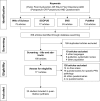Questionnaires to evaluate pelvic floor dysfunction in the postpartum period: a systematic review
- PMID: 30123009
- PMCID: PMC6087030
- DOI: 10.2147/IJWH.S164266
Questionnaires to evaluate pelvic floor dysfunction in the postpartum period: a systematic review
Abstract
Background: Pelvic floor dysfunctions (PFDs) affect the female population, and the postpartum period can be related to the onset or aggravation of the disease. Early identification of the symptoms and the impact on quality of life can be achieved through assessment instruments.
Objective: The purpose of this systematic review is to evaluate questionnaires used to assess PFD in the postpartum period.
Methods: A systematic review study was conducted, following Preferred Reporting Items for the Systematic Reviews and Meta-Analyses (PRISMA) criteria, using the databases: PubMed, Biblioteca Virtual de Saúde (BVS), Web of Science, and Scopus, and the keywords PFD or pelvic floor disorders, postpartum or puerperium, and questionnaire. Articles published up till May 2018 were included, searching for articles using validated questionnaires for the evaluation of PFDs in postpartum women. The articles included were evaluated according to a checklist, and the validation studies and translated versions of the questionnaires were identified.
Results: The search of the databases resulted in 359 papers, and 33 were selected to compose this systematic review, using nine validated questionnaires to assess PFDs in the postpartum period: International Consultation on Incontinence Questionnaire - Vaginal Symptoms (ICIQ-VS), Pelvic Floor Distress Inventory 20 (PFDI-20), Pelvic Floor Impact Questionnaire (PFIQ-7), PFDI-46, Pelvic Floor Impact Questionnaire (PFIQ-31), Pelvic Floor Bother Questionnaire (PFBQ), Female Pelvic Floor Questionnaire, electronic Personal Assessment Questionnaire - Pelvic Floor, and PFD questionnaire specific for pregnancy and postpartum. The most frequently reported questionnaires included PFDI-20, PFIQ-7, and ICIQ-VS and are recommended by ICI. In addition, the review identified a specific questionnaire, recently developed, to access PFD during pregnancy and postpartum.
Conclusion: The questionnaires used to evaluate PFD during postpartum period are developed for general population or urology/gynecology patients with incontinence and reinforce the paucity of highly recommended questionnaires designed for postpartum, in order to improve early and specific approach for this period of life.
Keywords: patient reported outcome measure; pelvic floor disorders; primary health care; puerperium; surveys and questionnaires; women’s health.
Conflict of interest statement
Disclosure The authors report no conflicts of interest in this work.
Figures
Similar articles
-
Reliability and validity of the Tigrigna version of the Pelvic Floor Distress Inventory-Short Form 20 (PFDI-20) and Pelvic Floor Impact Questionnaire-7 (PFIQ-7).Int Urogynecol J. 2019 Jan;30(1):65-70. doi: 10.1007/s00192-018-3583-9. Epub 2018 Mar 13. Int Urogynecol J. 2019. PMID: 29536138
-
Translation, reliability, and validity of Amharic versions of the Pelvic Floor Distress Inventory (PFDI-20) and Pelvic Floor Impact Questionnaire (PFIQ-7).PLoS One. 2022 Nov 17;17(11):e0270434. doi: 10.1371/journal.pone.0270434. eCollection 2022. PLoS One. 2022. PMID: 36395162 Free PMC article.
-
Responsiveness of the Spanish Pelvic Floor Distress Inventory and Pelvic Floor Impact Questionnaires Short Forms (PFDI-20 and PFIQ-7) in women with pelvic floor disorders.Eur J Obstet Gynecol Reprod Biol. 2015 Jul;190:20-5. doi: 10.1016/j.ejogrb.2015.03.029. Epub 2015 Apr 6. Eur J Obstet Gynecol Reprod Biol. 2015. PMID: 25955564
-
Effects of bariatric surgery on pelvic floor disorders in obese women: a meta-analysis.Arch Gynecol Obstet. 2017 Aug;296(2):181-189. doi: 10.1007/s00404-017-4415-8. Epub 2017 Jun 22. Arch Gynecol Obstet. 2017. PMID: 28643025 Review.
-
[Knowledge of pelvic floor disorders in peripartum women: A systematic review].Prog Urol. 2021 Mar;31(4):204-214. doi: 10.1016/j.purol.2020.10.009. Epub 2020 Nov 30. Prog Urol. 2021. PMID: 33272785 French.
Cited by
-
Swedish validation of the Pelvic Floor Questionnaire for pregnant and postpartum women.Int Urogynecol J. 2022 Nov;33(11):3013-3024. doi: 10.1007/s00192-022-05264-9. Epub 2022 Jun 29. Int Urogynecol J. 2022. PMID: 35767025 Free PMC article.
-
Development and initial validation of a Swedish inventory to screen for symptoms of deficient perineum in women after vaginal childbirth: 'Karolinska Symptoms After Perineal Tear Inventory'.BMC Pregnancy Childbirth. 2022 Aug 13;22(1):638. doi: 10.1186/s12884-022-04964-w. BMC Pregnancy Childbirth. 2022. PMID: 35964017 Free PMC article.
-
Clinical Presentation and Physiotherapy Rehabilitation of Cauda Equina Syndrome with Urinary Incontinence: A Case Report.Cureus. 2024 Sep 26;16(9):e70236. doi: 10.7759/cureus.70236. eCollection 2024 Sep. Cureus. 2024. PMID: 39463676 Free PMC article.
-
Self-reported reproductive health of retired elite women's footballers: a cross-sectional study.BMJ Open Sport Exerc Med. 2024 Jul 29;10(3):e002028. doi: 10.1136/bmjsem-2024-002028. eCollection 2024. BMJ Open Sport Exerc Med. 2024. PMID: 39493422 Free PMC article.
-
Pelvic floor symptoms according to the severity of second-degree perineal tears within 12 months post-partum: A longitudinal prospective cohort study.Acta Obstet Gynecol Scand. 2024 Jul;103(7):1366-1376. doi: 10.1111/aogs.14854. Epub 2024 May 6. Acta Obstet Gynecol Scand. 2024. PMID: 38709004 Free PMC article.
References
-
- Walker GJA, Gunasekera P. Pelvic organ prolapse and incontinence in developing countries: review of prevalence and risk factors. Int Urogynecol J. 2011;22(2):127–135. - PubMed
-
- Wu JM, Hundley AF, Fulton RG, Myers ER. Forecasting the prevalence of pelvic floor disorders in U.S. Women: 2010 to 2050. Obstet Gynecol. 2009;114(6):1278–1283. - PubMed
-
- Groutz A, Rimon E, Peled S, et al. Cesarean section: Does it really prevent the development of postpartum stress urinary incontinence? a prospective study of 363 women one year after their first delivery. Neurourol Urodyn. 2004;23(1):2–6. - PubMed
Publication types
LinkOut - more resources
Full Text Sources
Other Literature Sources
Medical


